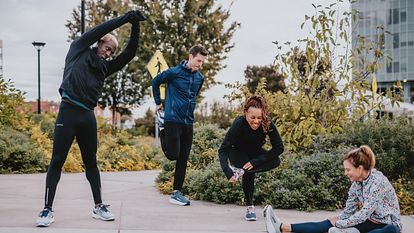
The Importance of Rest Days and How to Do Them Right
You might assume that runners would welcome a day of recovery after a week’s worth of running and strength training, but most athletes have trouble embracing rest days. This includes everyone from the beginning runner to the professional athlete. After spending so much time and energy pursuing even the most minute fitness gains, who wants to risk losing it all for something as trivial as rest?
However, rest days are the multivitamins of our running longevity. As we rest, our bodies repair themselves, ultimately enabling us to run faster and feel stronger.
“Intense training and racing can cause musculoskeletal damage through prolonged high output and those small deformities can lead to adaptation given time without loading,” says Megan Roche, a professional runner, coach, physician and clinical researcher. “Take blood samples from an athlete after a tough race and you’ll see lots of abnormalities at the cellular and systems level, particularly elevated cortisol from stress and creatine kinase from muscle damage. With the proper time to recover, though, the body can bounce back stronger from the stress.”
Even when runners lean into recovery, though, the question of how to rest can be confusing. As science writer Christi Aschwanden says in her book “Good to Go: What the Athlete in All of Us Can Learn from the Science of Recovery,” “It’s a fundamental issue facing athletes at every level—how much should I push and how much should I rest?”

How to take a rest day
Recovery and the different modalities one can take to find it are a burgeoning movement. Everything from cryotherapy and special protein powders to floating and infrared saunas are becoming common practices for amateur and elite athletes alike to alleviate sore muscles.
For those lacking the time to visit a recovery center or the funds to purchase the latest superfood, take comfort in the fact that rest—both non-running time and sleep—is the best recovery tool around, especially when it comes to preventing injury. Another easy way to prevent injury is by carving out time each week with the foam roller to focus on different muscle groups, which can increase range of motion.
“I find that athletes who don't focus on rest and recovery tend to roll the dice more often with injury, overtraining and mental burnout,” says Roche. “Two to three days of rest early on can save an athlete two to three weeks, or two to three months, of rest and injury frustration in the long term.”
Roche prescribes rest days to all of her athletes, regardless of their level.
“Some of my athletes go longer durations without rest days (like eight to ten days), but most are on a schedule of taking at least a Monday rest day each week,” she says.
Knowing the amount of rest one needs is highly individual and should take into account age, running background, fitness level, injury history, work, and life stresses. Roche says, “It varies dramatically from athlete to athlete and even within the same athlete based on goals, racing schedule and overall approach.”
Along with incorporating rest days, taking time completely off following a race is necessary at both a physiological and emotional level. Jumping into training too soon can lead to mental and physical burnout, as well as increasing the risk of common overuse injuries. Determining that time, however, can vary--highlighting the importance of listening to your body.
How much rest do I need?

In general, Roche suggests resting anywhere from three days after a 5K to up to two full weeks after a 100-miler. Keep in mind that, after longer races, your nervous system and glycogen stores will also need time to recover.
While recovery days usually consist of little more than short walks (and in some cases, nothing more than walking to the fridge for more food), on later rest days Roche encourages easy hiking, yoga or cross training, so long as you keep your heart rate low. Light movement can help increase blood flow to your legs and promote much-needed recovery of muscles and tissues.
Not surprisingly, most athletes have a difficult time accepting rest, even when they understand its importance. Social media movements like #restdaybrags have started to encourage the dialogue—and occasional frustrations—of taking time off. When asked how Roche herself tackles rest days, she says rest is easier when her identity isn’t fully defined by running.
“My career has followed what Michelle Obama refers to as a swerve, and so there have been times where I’ve been more defined as a runner than anything else,” she says.
Finding identities and interests outside of running can help alleviate that pressure, whether through work, relationships or hobbies. For athletes struggling with rest days, Roche encourages listening to podcasts, reading interesting books, studying a new subject or tackling a challenging thought question.
As for Roche’s preferred way to recover?
“I like spending time outside in nature moving as slowly as possible.” But, she adds, “I’m often in a permanent state of laundry crisis and rest days usually help with that.”
Whatever recovery method you choose, be sure it's something you can stick to even when the urge to run strikes. By creating and maintaining a regular recovery routine, you can stave off injury, avoid burnout and stay excited about running for the long haul.
By Jade de la Rosa. Jade is a freelance writer and ultra runner based in Bellingham, Washington. She holds an MFA in Creative Writing and is working on her first historical fiction novel.



Join our Newsletter
Get deals, events, and more.
Connect with Fleet Feet
Get involved on social media.
Find a Location
Fleet Feet has over 250 locations nationwide!
Find a Store